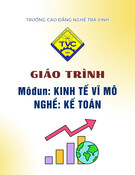
introduction chapters
chapter 9
Long-term Investments
goals discussion goals achievement fill in the blanks multiple choice problems check list and key terms
GOALS
Your goals for this "long-term investments" chapter are to learn about:
•How intent influences the accounting for investments.
•The correct accounting for "available for sale" securities.
•Accounting for securities that are to be "held to maturity."
•Special accounting for certain long-term equity investments that require use of the equity
method.
•Special accounting for certain long-term equity investments that require consolidation.
DISCUSSION
INTENT-BASED ACCOUNTING
INTENT-BASED ACCOUNTING: In an earlier chapter you learned about accounting for "trading
securities." Recall that trading securities are investments that were made with the intent of
reselling them in the very near future, hopefully at a profit. Such investments are considered
highly liquid and are classified on the balance sheet as current assets. They are carried at fair
market value, and the changes in value are measured and included in the operating income of
each period.
However, not all investments are made with the goal of turning a quick profit. Many investments
are acquired with the intent of holding them for an extended period of time. The appropriate
accounting methodology depends on obtaining a deeper understanding of the nature/intent of the
particular investment. You have already seen the accounting for "trading securities" where the
intent was near future resale for profit. But, many investments are acquired with longer-term
goals in mind.

For example, one company may acquire a majority (more than 50%) of the stock of another. In
this case, the acquirer (known as the parent) must consolidate the accounts of the subsidiary. At
the end of this chapter we will briefly illustrate the accounting for such "control" scenarios.
Sometimes, one company may acquire a substantial amount of the stock of another without
obtaining control. This situation generally arises when the ownership level rises above 20%, but
stays below the 50% level that will trigger consolidation. In these cases, the investor is deemed
to have the ability to significantly influence the investee company. Accounting rules specify the
"equity method" of accounting for such investments. This, too, will be illustrated within this
chapter.
Not all investments are in stock. Sometimes a company may invest in a "bond" (you have no
doubt heard the term "stocks and bonds"). A bond payable is a mere "promise" (i.e., bond) to
"pay" (i.e., payable). Thus, the issuer of a bond payable receives money today from an investor
in exchange for the issuer's promise to repay the money in the future (as you would expect,
repayments will include not only amounts borrowed, but will also have added interest). In a later
chapter, we will have a detailed look at Bonds Payable from the issuer's perspective. In this
chapter, we will undertake a preliminary examination of bonds from the investor's perspective.
Although investors may acquire bonds for "trading purposes," they are more apt to be obtained
for the long-pull. In the latter case, the bond investment would be said to be acquired with the
intent of holding it to maturity (its final payment date) -- thus, earning the name "held-to-maturity"
investments. Held-to-maturity investments are afforded a special treatment, which is generally
known as the amortized cost approach.
By default, the final category for an investment is known as the "available for sale" category.
When an investment is not trading, not held-to-maturity, not involving consolidation, and not
involving the equity method, by default, it is considered to be an "available for sale" investment.
Even though this is a default category, do not assume it to be unimportant. Massive amounts of
investments are so classified within typical corporate accounting records. We will begin our look
at long-term investments by examining this important category of investments.
The following table recaps the methods you should be familiar with by the conclusion of this
chapter:

THE FAIR VALUE MEASUREMENT OPTION: The Financial Accounting Standards Board
recently issued a new standard, "The Fair Value Option for Financial Assets and Financial
Liabilities." Companies may now elect to measure certain financial assets at fair value.
This new ruling essentially allows many "available for sale" and "held to maturity"
investments to instead be measured at fair value (with unrealized gains and losses
reported in earnings), similar to the approach previously limited to trading securities. It is
difficult to predict how many companies will select this new accounting option, but it is
indicative of a continuing evolution toward valued-based accounting in lieu of traditional
historical cost-based approaches.
AVAILABLE FOR SALE SECURITIES
SIMILAR TO TRADING SECURITIES: The accounting for "available for sale" securities
will look quite similar to the accounting for trading securities. In both cases, the
investment asset account will be reflected at fair value. If you do not recall the accounting
for trading securities, it may be helpful to review that material via the indicated link.
To be sure, there is one big difference between the accounting for trading securities and
available-for-sale securities. This difference pertains to the recognition of the changes in value.
For trading securities, the changes in value were recorded in operating income. However, such is
not the case for available-for-sale securities. Here, the changes in value go into a special
account. We will call this account Unrealized Gain/Loss- OCI, where "OCI" will represent "Other
Comprehensive Income."
OTHER COMPREHENSIVE INCOME: This notion of other comprehensive income is somewhat
unique and requires special discussion at this time. There is a long history of accounting
evolution that explains how the accounting rule makers eventually came to develop the concept
of OCI. To make a long story short, most transactions and events make their way through the
income statement. As a result, it can be said that the income statement is "all-inclusive." Once
upon a time, this was not the case; only operational items were included in the income
statement. Nonrecurring or nonoperating related transactions and events were charged or

credited directly to equity, bypassing the income statement entirely (a "current operating" concept
of income).
Importantly, you must take note that the accounting profession now embraces the all-inclusive
approach to measuring income. In fact, a deeper study of accounting will reveal that the income
statement structure can grow in complexity to capture various types of unique transactions and
events (e.g., extraordinary gains and losses, etc.) -- but, the income statement does capture
those transactions and events, however odd they may appear.
There are a few areas where accounting rules have evolved to provide for special
circumstances/"exceptions." And, OCI is intended to capture those exceptions. One exception is
the Unrealized Gain/Loss - OCI on available-for-sale securities. As you will soon see, the
changes in value on such securities are recognized, not in operating income as with trading
securities, but instead in this unique account. The OCI gain/loss is generally charged or credited
directly to an equity account (Accumulated OCI), thereby bypassing the income statement ( there
are a variety of reporting options for OCI, and the most popular is described here).
AN ILLUSTRATION: Let us amend the Chapter 6 trading securities illustration -- such that the
investments were more appropriately classified as available for sale securities:
Assume that Webster Company acquired an investment in Merriam Corporation. The intent was
not for trading purposes, control, or to exert significant influence. The following entry was needed
on March 3, 20X6, the day Webster bought stock of Merriam:
3-3-X6 Available for Sale Securities 50,000
Cash 50,000
To record the purchase of 5,000 shares of
Merriam stock at $10 per share
Next, assume that financial statements were being prepared on March 31. By that date,
Merriam's stock declined to $9 per share. Accounting rules require that the investment "be
written down" to current value, with a corresponding charge against OCI. The charge is recorded
as follows:
3-31-X6 Unrealized Gain/Loss - OCI 5,000
Available for Sale Securities 5,000
To record a $1 per share decrease in the
value of 5,000 shares of Merriam stock
This charge against OCI will reduce stockholders' equity (the balance sheet remains in balance
with both assets and equity being decreased by like amounts). But, net income is not reduced,
as there is no charge to a "normal" income statement account. The rationale here, whether you
agree or disagree, is that the net income is not affected by temporary fluctuations in market value
-- since the intent is to hold the investment for a longer term period.
During April, the stock of Merriam bounced up $3 per share to $12. Webster now needs to
prepare this adjustment:
4-30-X6 Available for Sale Securities 15,000
Unrealized Gain/Loss - OCI 15,000

To record a $3 per share increase in the
value of 5,000 shares of Merriam stock
Notice that the three journal entries now have the available for sale securities valued at $60,000
($50,000 - $5,000 + $15,000). This is equal to their market value ($12 X 5,000 = $60,000). The
OCI has been adjusted for a total of $10,000 credit ($5,000 debit and $15,000 credit). This
cumulative credit corresponds to the total increase in value of the original $50,000 investment.
The preceding illustration assumed a single investment. However, the treatment would be the
same even if the available for sale securities consisted of a portfolio of many investments. That
is, each and every investment would be adjusted to fair value.
ALTERNATIVE -- A VALUATION ADJUSTMENTS ACCOUNT: As an alternative to directly
adjusting the Available for Sale Securities account, some companies may maintain a separate
Valuation Adjustments account that is added to or subtracted from the Available for Sale
Securities account. The results are the same; the reasons for using the alternative approach is to
provide additional information that may be needed for more complex accounting and tax
purposes. This coverage is best reserved for more advanced courses.
DIVIDENDS AND INTEREST: Dividends or interest received on available for sale securities is
reported as income and included in the income statement:
9-15-X5 Cash 75
Dividend Income 75
To record receipt of dividend on available
for sale security investment
THE BALANCE SHEET APPEARANCE: The above discussion would produce the following
balance sheet presentation of available for sale securities at March 31 and April 30. To aid the
illustration, all accounts are held constant during the month of April, with the exception of those
that change because of the fluctuation in value of Merriam's stock.







![Bài giảng Kiểm toán nợ phải thu khách hàng [chuẩn nhất]](https://cdn.tailieu.vn/images/document/thumbnail/2025/20250710/huyhuy2345/135x160/485_bai-giang-kiem-toan-no-phai-thu-khach-hang.jpg)
![Nội dung câu hỏi trắc nghiệm Kế toán [chuẩn nhất]](https://cdn.tailieu.vn/images/document/thumbnail/2025/20250710/quynhnhuthpy@gmail.com/135x160/637_noi-dung-cau-hoi-trac-nghiem-ke-toan.jpg)






![Đề thi Kế toán ngân hàng kết thúc học phần: Tổng hợp [Năm]](https://cdn.tailieu.vn/images/document/thumbnail/2025/20251014/embemuadong09/135x160/19181760426829.jpg)










